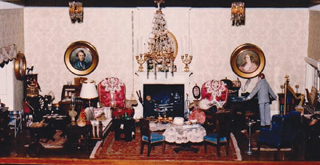Saluting Canadian Culture

ANSWER: Two things actually: They are all culturally significant treasures identified by a group of curators representing nearly a dozen national institutions and they are among the subjects tackled by Concordia graduate students offered an extraordinary opportunity in Loren Lerner’s museum practice seminar last year.
Each student participated in an elaborate exercise that saw them visit two objects or sites in Ottawa, research the works extensively, and then prepare texts on each one. “It was a tremendous amount of work,” recalls Lerner. “They had to make the text informational, educational and accessible and find something new about the work.”
Those 52 texts have been uploaded weekly onto the Canada’s Got Treasures Website as part of virtualmuseum. ca maintained under the auspices of the Canadian Heritage Information Network (CHIN), a division of the Department of Canadian Heritage. The last of those entries will go up in mid-November.
As chair of the Department of Art History, Lerner was approached by CHIN’s Senior Heritage Information Analyst Wendy Thomas, who knew the department and thought the students would be an excellent resource. “We were thinking about how museums could use social media to connect with their audience, and to have their audiences connect with each other,” says Thomas.

Lerner was interested in the project, both as an exercise for her students, and because of the scope of the materials represented. “The project demonstrates the fact that we’re interested in all aspects of visual culture,” says Lerner. “It includes a range of people, places and things not necessarily conceived in an artistic milieu.”
The students wrote several versions of their texts, both for class and, later, for the curator who had selected the work. “The museums were really impressed with the quality of the students’ work, and the students benefitted from one-on-one feedback,” reports Thomas. She adds that the students were able to adapt their usually scholarly approach to a web-level audience.
But the students’ challenges didn’t end there. They were also responsible for writing a script for an accompanying one-minute video shot by YoungCuts, a film production project of filmmakers under 25, many of whom are Concordia graduates. Recent MA graduate, Dina Vescio, helped coordinate travel, deadlines and communication between all involved.

Photography students in Marisa Portolese’s class were invited to take photos that mirrored the feeling evoked by the works. The students in Lerner’s class worked with the photographer, interviewing them and writing their artist statement. These texts, along with the photos and videos, can all by found on the Canada’s Got Treasures site.
Oh, and that cow mentioned above? Turns out the Canadian Agricultural Museum has designated la Canadienne, adapted to our climate and the only dairy cow bred in North America, amongst Canada’s treasures. Maya Soren wrote the text and researched representation of cows in Canadian painting and visual culture as part of her contribution to the site.
Thomas was so impressed by the experience that she will be presenting it at the Universities Art Association of Canada’s annual conference held Oct. 14 to 16 in Guelph. Meanwhile, other classes, including Elizabeth Cavaliere’s art history class on photography and Montreal, have gotten involved.
In addition to CHIN, the project involved the Canadian Museum of Civilization, the Canadian War Museum, the National Gallery of Canada, Canada Science and Technology Museum, Canada Aviation and Space Museum, Canada Agriculture Museum, and the Canadian Museum of Nature, as well as the National Capital Commission and Library and Archives Canada.
Related links:
- Young Cuts
- Canada's Got Treasures!
- Concordia's Art History Department